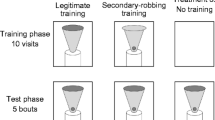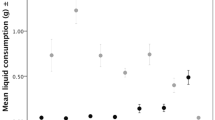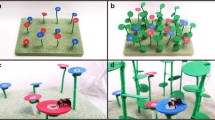Summary
To study risk aversion in hand-reared bananaquits (Coereba flaveola) we placed individuals in a cage with a 1 m2 floral board having a random array of 85 yellow and 85 red artificial flowers. Flowers of one color were filled with the same quantity of nectar (constant flowers), whereas flowers of the other color were filled with variable quantities of nectar (variable flowers). The constant and variable flowers had identical mean contents, only their variances differed. After three presentations, the constant flowers were made variable and vice versa to control for color preferences. Naive foragers tended to avoid variable flowers. The degree of risk aversion was influenced by previous experience, the relative variability of the variable flowers, and flower color. Variable flowers having similar coefficients of variation, but different reward variables (volume or concentration) resulted in similar levels of risk aversion. Within single foraging episodes the following was observed: sequences of constant flowers increased while sequences of variable flowers remained similar to random foraging; the probability of revisiting a constant flower was higher than revisiting a variable flower; the average amount of nectar consumed from constant and variable flowers was similar within the assessment periods (prior to favoring constant flowers); the proportion of visits falling below the mean expected reward during the assessment period or its inverse (the proportion visited with at least the equivalent of the mean) may be a cue used for risk aversion; risk aversion persisted through long foraging bouts despite changed nectar distributions suggesting that the bananaquits did not track resource distributions well within foraging bouts.
Similar content being viewed by others
References
Baker HG (1975) Sugar concentrations in nectars from humingbird flowers. Biotropica 7:137–141
Caraco T (1980) On foraging time allocation in a stochastic environment. Ecology 61:119–128
Caraco T (1981) Energy budgets, risk and foraging preferences in Dark-eyed Juncos (Junco hyemalis). Behav Ecol Sociobiol 8:213–217
Caraco T (1982) Aspects of risk aversion in foraging White-crowned Sparrows. Anim Behav 30:719–727
Caraco T, Martindale S, Whittam TS (1980) An empirical demonstration of risk-sensitive foraging preferences. Anim Behav 28:820–830
Cole S, Hainsworth FR, Kamil AC, Mercier T, Wolf LL (1982) Spatial learning as an adaptation in hummingbirds. Science 217:655–657
Gill FB, Wolf LL (1977) Nonrandom foraging by sunbirds in a patchy environment. Ecology 58:1284–1296
Hainsworth FR, Wolf LL (1972) Crop volume, nectar concentration, and hummingbird energetics. Comp Biochem Physiol 42:359–366
Hainsworth FR, Wolf LL (1976) Nectar characteristics and food selection by hummingbirds. Oecologia 25:101–113
Kamil AC (1978) Systematic foraging by a nectar-feeding bird, the Amakihi (Loxops virens). J Comp Physiol Psychol 92:388–396
Krebs JR, Stephens DW, Sutherland WS (1983) Perspectives in optimal foraging. In: Brush AH, Clark GA (eds) Perspectives in ornithology. Cambridge University Press, Cambridge, pp 165–216
Krebs JR, Erichsen TJ, Webber MI, Charnov EL (1977) Optimal prey selection in the Great Tit (Parus major). Anim Behav 25:30–38
Lack D (1976) Island biology, illustrated by the land birds of Jamaica. Blackwell Sci Publ, Oxford
MacArthur RH, Wilson EO (1967) The theory of island biogeography. Princeton University Press, Princeton
Moynihan M (1968) The “Coerebini”, a group of marginal areas, habitats, and habits. Am Nat 102:573–581
Oster G, Wilson EO (1978) Caste and ecology in the social insects. Princeton University Press, Princeton
Pyke GH, Pulliam HR, Charnov EL (1977) Optimal foraging: a selective review of theory and tests. Quart Rev Biol 52:137–154
Real L (1980a) Fitness, uncertainty, and the role of diversification in evolution and behavior. Am Nat 115:623–638
Real L (1980b) On uncertainty and the law of diminishing returns in evolution and behavior. In: Staddon JER (ed) Limits to Action. Academic Press, New York
Real L (1981) Uncertainty and pollinator-plant interactions: the foraging behavior of bees and wasps on artificial flowers. Ecology 62:20–26
Skutch AF (1954) Life histories of Central American birds. Pac Coast Avif No. 31
Snow BK, Snow DW (1971) The feeding ecology of tanagers and honeycreepers. Auk 88:291–322
Stephens DW (1981) The logic of risk-sensitive foraging preferences. Anim Behav 29:628–629
Stephens DW, Charnov EL (1982) Optimal foraging: some simple stochastic models. Behav Ecol Sociobiol 10:251–263
Stiles FG (1975) Ecology, flowering phenology, and hummingbird pollination of some Costa Rican Heliconia species. Ecology 56:285–301
Thompson WA, Vertinsky I, Krebs JR (1974) The survival value of flocking in birds: a simulation model. J Anim Ecol 785–820
Waddington KD, Allen T, Heinrich B (1981) Floral preferences of bumblebees (Bombus edwardsii) in relation to variable versus fixed rewards. Anim Behav 29:779–784
Werner EE, Hall DJ (1974) Optimal foraging and the size selection of prey by the bluegill sunfish (Lepomis macrochirus). Ecology 55:1042–1052
Wunderle JM (1981) Movements of adult and juvenile bananaquits within a morph ratio cline. Auk 98:571–577
Author information
Authors and Affiliations
Rights and permissions
About this article
Cite this article
Wunderle, J.M., O'Brien, T.G. Risk aversion in hand-reared bananaquits. Behav Ecol Sociobiol 17, 371–380 (1985). https://doi.org/10.1007/BF00293215
Received:
Accepted:
Issue Date:
DOI: https://doi.org/10.1007/BF00293215




